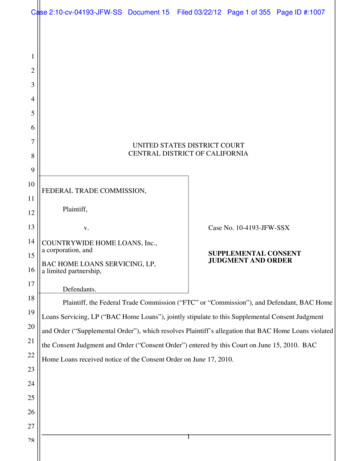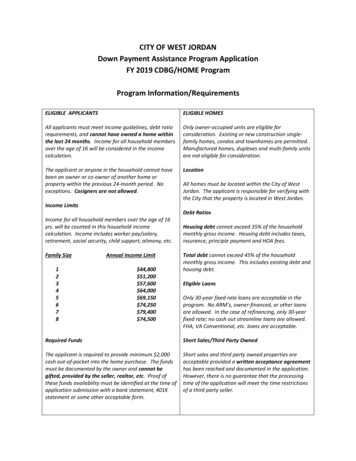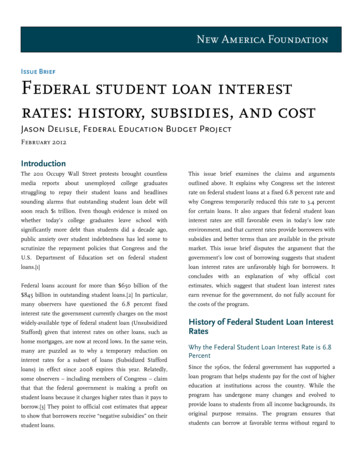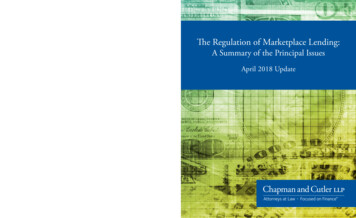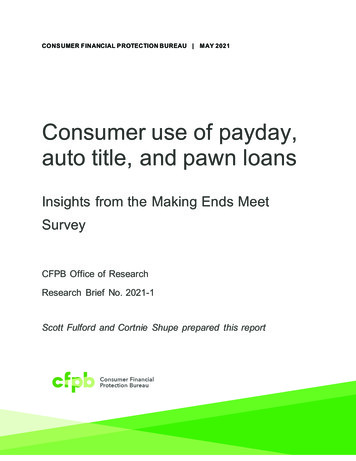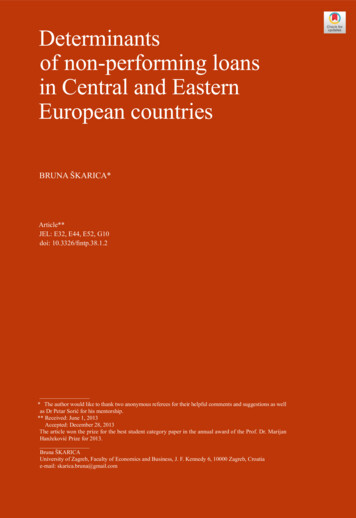
Transcription
Article**JEL: E32, E44, E52, G10doi: 10.3326/fintp.38.1.2* The author would like to thank two anonymous referees for their helpful comments and suggestions as wellas Dr Petar Sorić for his mentorship.** Received: June 1, 2013Accepted: December 28, 2013The article won the prize for the best student category paper in the annual award of the Prof. Dr. MarijanHanžeković Prize for 2013.Bruna ŠKARICAUniversity of Zagreb, Faculty of Economics and Business, J. F. Kennedy 6, 10000 Zagreb, Croatiae-mail: skarica.bruna@gmail.combruna škarica:determinants of non-performing loans in central and eastern european countriesBRUNA ŠKARICA*37financial theory andpractice38 (1) 37-59 (2014)Determinantsof non-performing loansin Central and EasternEuropean countries
38financial theory andpractice38 (1) 37-59 (2014)abstractThis paper analyses the determinants of the changes in the non-performing loan(NPL) ratio in selected European emerging markets. The model was estimated ona panel dataset using a fixed effects estimator for seven Central and Eastern European (CEE) countries between Q3:2007 and Q3:2012. The countries analyzedare Bulgaria, Croatia, Czech Republic, Hungary, Latvia, Romania and Slovakia.Although the literature on NPLs is quite extensive, this is the first empirical research on the countries of CEE region using aggregate, country-level data on problem loans. The results suggest that the primary cause of high levels of NPLs isthe economic slowdown, which is evident from statistically significant and economically large coefficients on GDP, unemployment and the inflation rate.bruna škarica:determinants of non-performing loans in central and eastern european countriesKeywords: non-performing loans, macro-financial linkages, Central and EasternEurope, panel regressions, financial stability1 introductionThe recent financial crisis has left a legacy of extremely high levels of NPLs in theCEE region. In 2008, countries that had based their economic growth on the booming banking sector (Sirtaine and Skamnelos, 2007) at the beginning of the pastdecade found themselves faced with a sudden credit growth halt (EuropeanBanking Coordination ‟Vienna” Initiative, 2012). This is attributable to both thereduced demand for financing and reduced willingness to lend on the part of theEuropean banks. The high levels of NPLs are becoming a growing issue, giventhat experiences from past financial crises show that a lasting recovery requires a‟clean-up” of the financial sector. It is also clear that NPLs induce uncertainty andimpact the banks’ willingness and ability to keep lending, therefore affecting aggregate demand and investments. Furthermore, unresolved NPLs suppress theeconomic activity of currently overextended borrowers and trap resources inunproductive uses. All of these problems are particularly prominent in the CEEregion, where recovery following the extreme economic slowdown has been veryweak. To illustrate the strong impact of the global recession on the economic performance of CEE countries, it is sufficient to state that in 2009 all of the 7 countries analyzed in this paper suffered negative annual real GDP growth rates of over4% (Latvia’s economy, for example, contracted by 17.7% in 2009, on a year-toyear basis).Moreover, despite the efforts from the banking sector and regulatory institutions,NPL levels still remain high, especially compared with the advanced economiesin Western Europe. Table 1 shows World Bank data on annual NPL levels for 10selected advanced European economies. According to the data, the levels of NPLsgrew throughout the four-year crisis period in these economies as well, but havenot risen above 5%. In the CEE region, on the other hand, Bulgaria, Romania,Latvia and Croatia finished 2011 with NPL ratios of 16.87%, 14.3%, 17.23% and12.27% respectively.
39figure 1Annual levels of NPLs, 2008-20114.54.03.5financial theory andpractice38 (1) 37-59 h the literature on NPLs is quite extensive, this is the first empirical research on the countries of CEE region using aggregate, country-level data on problem loans. This empirical analysis includes 7 countries of the CEE region: Bulgaria, Croatia, Czech Republic, Hungary, Latvia, Romania and Slovakia. It needspointing out that the choice of the countries analyzed (as well as the observed timeperiod) was determined primarily by the scarcity of data on NPLs. The data wascollected from quarterly financial stability reports by central banks of the 7countries included in the research; no earlier data were available for all 7 countries(or other CEE countries) – therefore, in order to have a balanced panel for all 7countries, with aggregate data, this time period was chosen. The model was estimated on a panel dataset using ordinary least squares and including fixed effects.The results suggest that the primary cause of high levels of NPLs is the extremeeconomic slowdown.The rest of the paper is organized as follows. Section two provides a summary ofthe relevant literature discussing the determinants of NPLs. Section three describes some stylized facts about recent developments in the banking sectors of theCEE countries, data used in the analysis and states the potential impact of eachvariable on the NPL ratio. This is followed by a description of methodology andthe presentation of results. Section five concludes.2 literature overviewThe macroeconomic determinants of NPLs, or the quality of bank assets in general, have generated a substantial amount of interest since the outbreak of the financial crisis in the autumn of 2008.There is a rich theoretical literature on the subject of the interactions between thefinancial system and the wider economy. The most prominent examples are Bernanke and Gertler (1989) and Bernanke, Gertler and Gilchrist (1998) who develo-bruna škarica:determinants of non-performing loans in central and eastern european countriesSource: World Bank.
40financial theory andpractice38 (1) 37-59 (2014)ped the concept of the ‟financial accelerator”, arguing that credit markets areprocyclical and that information asymmetries between lenders and borrowers aswell as the balance sheet effect work to amplify and propagate credit marketshocks to the economy. The Kiyotaki and Moore (1997) model showed how relatively small shocks might suffice to explain business cycle fluctuations, if creditmarkets are imperfect.bruna škarica:determinants of non-performing loans in central and eastern european countries2.1 empirical studies: single economy analysesKeaton and Morris (1987) introduced one of the earliest empirical studies onNPLs investigating the causes of loan loss diversity on a sample of 2,500 banks inthe USA. Their study showed that a substantial part of the variation in loan losseswas due to differences in local economic conditions and to unusually poor performance in particular industries like agriculture and energy. On the other hand, onlya minor part of the remaining variation in losses can be attributed to bank-levelfactors, such as banks deliberately taking greater risks and granting loans that theyknew had a high probability of default. Gambera (2000) also analyzed quarterlydata on US loans to prove the link between macroeconomic dynamics and bankasset quality. The empirical results suggest that a limited number of regional andnational macroeconomic variables are often good predictors of problem loan ratios, and that simple, bivariate VAR systems of one bank variable, one macroeconomic variable, and seasonal dummies can be quite effective. These variables include bankruptcy filings, farm income (particularly for countries where farminghas an important role), state annual product, housing permits, and unemployment.Furthermore, VAR methodology was also used in the studies by Blaschke andJones (2001) for USA, Baboučak and Jančar (2005) for Czech Republic and Hoggarth, Logan and Zicchino (2005) for the United Kingdom. The latter employedUK quarterly data to evaluate the dynamics between banks’ write-off-to-loan ratioand several macroeconomic variables. They found that the important factors influencing financial stability and loan portfolio quality were the dynamics of inflation and interest rates. Baboučak and Jančar (2005) found evidence of positivecorrelation between the NPLs, unemployment rate and consumer price inflation,whereas GDP growth decelerates the NPL ratio. They also found that the real effective exchange rate appreciation does not exacerbate the NPL ratio. Salas andSaurina (2002) compared the determinants of problem loans of Spanish commercial and savings banks, taking into account both the macroeconomic and individual bank-level variables. The GDP growth rate, corporate and family indebtedness, rapid past credit or branch expansion, inefficiency, portfolio composition, size, net interest margin, capital ratio, and market power are all variablesthat explain credit risk. Jimenez and Saurina (2006) presented an extended pieceof research on NPL determinants in Spain, demonstrating that the acceleration ofGDP, as well as the decline in real interest rates, brings about a decline in problemloans. They also found that credit growth lagged four years has a positive and significant influence on NPLs, proving that the rapid credit growth today results inlower credit standards and, eventually in higher levels of problem loans. Rajan
bruna škarica:determinants of non-performing loans in central and eastern european countries2.2 panel analysesThe Espinoza and Prasad (2010) study on the determinants of NPLs in the GulfCooperation Council (GCC) banking sector is one of the first examples of regionalempirical research on the topic. It uses a bank-wise panel dataset and fixed effect,difference GMM, and System GMM models. They found strong evidence of asignificant inverse relationship between real (non-oil) GDP and NPLs. Their studyalso attempted to estimate the feedback from rising NPLs to the real economyusing a panel VAR. Overall, the model suggested that there is strong but shortlived feedback effect on non-oil growth in the GCC. Nkusu (2011) analyzed NPLdeterminants and feedback effects for a panel of 26 advanced economies. Thefindings are in line with previous studies and expectations. They confirm that deterioration in the macroeconomic environment (proxied by slower growth, higherunemployment or falling asset prices) is associated with debt service problems,reflected into rising NPLs. Finally, according to Beck, Jakubik and Piloiu (2013),who used a panel of 75 countries, real GDP growth, share prices, exchange rateand lending interest rate significantly affect NPL ratios. Overall, it can be statedthat a considerable amount of empirical evidence regarding the anti-cyclical behavior of NPLs can be found. The common finding of all these studies is that when41financial theory andpractice38 (1) 37-59 (2014)and Dahl (2003) used panel regression models to suggest that credit terms have asignificant effect on Indian non-performing loans in the presence of bank size induced risk preferences and macroeconomic shocks. The changes in the cost ofcredit in terms of expectations of higher interest rates induce a rise in NPLs. Onthe other hand, factors like the horizon of maturity of credit, better credit culture,favorable macroeconomic and business conditions all lead to the lowering ofNPLs. Quagliariello (2003) presented a regression between the evolution of Italian NPLs as the dependent variable and a set of explanatory variables: the realGDP growth rate, growth of real gross fixed investment and consumption, changein the unemployment rate, CPI, real exchange rate and M2 growth rate. He showed that the declining GDP growth and increasing unemployment rate have a significant negative effect on loan portfolio quality in Italy. Arpa et al. (2001) alsoapplied regression analysis showing that risk provisions in the total loans of theAustrian banking sector vary with real GDP growth, CPI inflation, real estate priceinflation and real interest rates. Shu (2002) examined the NPL ratio in Hong Kongusing regression models. His analysis showed that the increasing NPL ratio can beattributed to the increasing nominal interest rates and the number of bankruptcies,whereas the NPL ratio decreases with higher CPI inflation, economic growth andproperty price inflation. Louzis, Vouldis and Metaxas (2011) explored both bankspecific and macroeconomic determinants of NPLs in Greece, using dynamic panel data sets separately for each loan category (consumer, business loans andmortgages). Their study shows that all categories of Greek NPLs can be explainedby macroeconomic variables (GDP growth, unemployment, interest rates, publicdebt) as well as by management quality.
42there is a slowdown in the economy, the NPL level is likely to increase, as unemployment rises and borrowers face greater difficulties in repaying their debt.financial theory andpractice38 (1) 37-59 (2014)3 data and stylized factsIn the following chapter, a discussion on the common treatment of the non-performing loans in macroeconomic statistics will be presented. In addition, the variables used in the analysis and their expected channel of impact on the NPL ratiowill be introduced, as well as a short overview of the banking sector in the CEEregion.bruna škarica:determinants of non-performing loans in central and eastern european countries3.1 dataThe dependent variable here is the ratio of NPLs to total (gross) loans. The definition of NPLs differs across countries and regions, so it is necessary to be cautiouswhen making international comparisons. The main problem with the NPL data isthat there is no internationally accepted standard for NPL measurement. Some ofthe most commonly used definitions are those by the IMF, Basel Committee forBanking Supervision (BCBS), Institute of International Finance (IIF) and the International Financial Reporting Standards (IFRS). The IMF’s definition of NPLswas developed in the framework of the Financial Soundness Indicators (FSIs).The FSI Compilation Guide of March 2006 (IMF, 2006) recommends that ‟loans(and other assets) should be classified as NPL when (1) payments of principal andinterest are past due by three months (90 days) or more, or (2) interest paymentsequal to three months (90 days) interest or more have been capitalized (re-invested into the principal amount), refinanced, or rolled over (i.e. payment has beendelayed by arrangement).” BIS (2006) also advises the 90 days rule, more precisely, ‟a default is considered to have occurred with regard to a particular obligorwhen the obligor is past due more than 90 days on any material credit obligationto the banking group.” Many national regulations follow the IIF recommendation(IIF, 1999) for classifying loans as standard, watch, substandard, doubtful andloss; non-performing loans usually comprise the categories substandard (interestand/or principal are more than 90 days overdue), doubtful (interest and/or principal are overdue more than 180 days) and loss loans (where the loan is virtuallyuncollectible; interest and/or principal are overdue for more than a year). The FSIwebsite as well as the World Bank’s database offer cross-country comparativepresentations of NPL time series. However, for most developing countries, theNPL data presented by both sources are not yet comprehensive, as the time seriesare rather limited. The data on the NPL ratio in this study is therefore collectedfrom the central banks’ databases of each country included in the analysis. Thisdata set contains quarterly observations for 7 countries of the Central and EasternEurope (CEE) region, from the third quarter of 2007 to the third quarter of 2012.The countries included in the sample are: Bulgaria, Croatia, Czech Republic,Hungary, Latvia, Romania and Slovakia. Reassuringly, the NPL series are highlycorrelated with the FSI data. Furthermore, recent research by Barisitz (2011) looks into the national definitions of NPLs in the CEE region and concludes that
NPL definitions based on national credit quality classifications of CEE countrieslargely appear to be comparable as they are based on the ‟90-days-past-due criterion”.The relevance and expected signs of the relationships between NPL ratio and theselected variables are as follows:– Following the results of previous empirical studies on NPLs and their proven countercyclical nature, it can be expected that real GDP growth andemployment will be negatively associated with NPLs. A growing economyincreases borrowers’ income and ability to repay debts and it generally increases overall financial stability.– An increase of NEER represents an appreciation of the domestic currency.Currency appreciation can weaken debt-servicing capabilities of exportoriented firms and thus increase the NPL ratio. However, it could also positively affect private debtors whose loans are denominated in foreign currency, reducing the NPL ratio. The sign of the relationship between NEERand the NPL ratio is thus indeterminate. However, it should be noted that thecountries of the CEE regions are known for a large proportion of foreigncurrency loans.– The HICP gives comparable measures of inflation in the countries in thesample. The relationship between NPLs and inflation is ambiguous. Theoretically, inflation should reduce the real value of debt and hence make debtbruna škarica:determinants of non-performing loans in central and eastern european countries3.2 variables and expected channels of impactThe independent variables are commonly used country-specific macroeconomicindicators and the level of loans in the banking sector. The aforementioned macroeconomic aggregates include the real GDP growth, unemployment rate, nominaleffective exchange rate (NEER), harmonised index of consumer prices (HICP),share prices index and the 3 month money market interest rate. The data on realGDP growth, unemployment rates, HICP, 3 month money market interest ratesand the share prices indices are obtained from Eurostat. Nominal effective exchange rates are calculated as geometric weighted averages of bilateral exchangerates, with 61 economies included in the basket, and are taken from the Bank forInternational Settlements database. The data on total loans refers to outstandingamounts of domestic loans in all currencies (originally in millions of euro) at theend of each period (quarter), and are retrieved from the European Central Bankstatistics.financial theory andpractice38 (1) 37-59 (2014)However, it should be noted that apart from the days of overdue, there are otherdifferences among the definitions and NPL classification criteria across countries.These include taking into account whether or not a judicial procedure has beenstarted against the debtor (e.g. Romania), reporting NPL levels net of provisions(instead of in gross terms, which is the international standard) and the role of collateral and guarantees.43
44financial theory andpractice38 (1) 37-59 (2014)bruna škarica:determinants of non-performing loans in central and eastern european countriesservicing easier. However, high inflation may pass through to nominal interest rates, reducing borrowers’ loan-servicing capacity or it can negativelyaffect borrowers’ real income when wages are sticky. It is also necessary toemphasize the short run relationship between inflation and NPLs as well. Ifthe income does not increase in line with inflation, a rise in inflation increases costs (for both households and corporates) and thus lowers the amountof available funds for debt repayment. Finally, price stability is generallyconsidered a prerequisite for economic growth. Bearing in mind thisbackground, the relationship between NPLs and inflation can be positive ornegative. Rinaldi and Sanchis-Arellano (2006) find a positive relationshipbetween the inflation rate and non-performing loans, while Shu (2002) reports a negative relation.– An increase in interest rates weakens borrowers’ debt servicing capacity,more so if loan rates are variable. Therefore, NPL is expected to be positively related to interest rates.– In the case of share prices, the direct impact on NPLs in not obvious. Beck,Jakubik and Piloiu (2013) use this variable in their examination of NPL determinants, assuming that share prices are correlated with housing prices, onwhich there are insufficient data. Empirical analysis should then reflect thenotion that a drop in the value of collateral for housing loans could negatively affect the quality of consumer loans. At the same time, shares, whilerarely used as collateral, might be correlated with other risky assets whichserve as a collateral for loans.– NPLs should increase following rapid credit growth; therefore the increaseof domestic loans should be associated with higher levels of NPLs. However, high loan levels could indicate high debt burdens, which make debtorsmore vulnerable to adverse shocks affecting their wealth or income, therebyraising the likelihood of running into debt-servicing problems.3.3 stylized factsThe CEE region was hit very hard by the global economic slowdown in 2009,especially given the high positive growth rates in the region in the period between2000 and 2007, i.e. prior to the global recession. In these years, Latvia, for example, had an average annual real GPD growth rate of 8.5%. However, in 2008Latvia was (alongside Estonia, which is not analyzed in this paper) the only country in the region with a contracting economy – GDP decreased by 2.8% from2007. In 2009, however, all of the countries in the sample had a negative GDPgrowth rate. The quarterly data shows that in 2009, in the third quarter, Latvia hadan almost incredible GDP decrease of 18.9%; the GDP numbers were also followed by a strong rise in the unemployment figures. In the third quarter of 2007 theunemployment rate in this country was 6.6%, whereas in the first quarter of 2010it reached 21.1%. Despite dramatic GDP figures from 2009, in 2011 all the countries in the region had positive real GDP growth rates – apart from Croatia.
Economic recovery in this country has been very slow, with persistently highunemployment rates. In 2012, however, two more countries slid back into recession – Czech Republic and Hungary.financial theory andpractice38 (1) 37-59 (2014)figure 2Real GDP growth vakiaSource: Eurostat.Figure 3 shows quarterly growth rates of all domestic loans, as compared to thesame quarter in the previous year. A strong downwards trend in loan growth ratescan be noticed in the graph for virtually all the countries of the CEE region in theperiod between the third quarter of 2007 and the beginning of 2009. As presentedin the banking overview section of this paper, a halt in credit demand, particularlyby households, is still a big problem in the countries of the region, and has beenslowing down further economic recovery.figure 3Loans growth rates50403020100-10BulgariaSource: 10Q1Q4Q3Q209Q1Q4Q3Q2Q408Q107Q3-20bruna škarica:determinants of non-performing loans in central and eastern european countries-15
46financial theory andpractice38 (1) 37-59 (2014)Apart from the second half of 2008 and the beginning of 2009 (the start of theglobal recession) – especially in Romania and Bulgaria, NEER has been relativelystable in all the analyzed countries. It can be argued that NEER is not an appropriate measure for exchange rate volatility in this analysis, and this will be furtherelaborated in the empirical section of the paper. Finally, inflation rates (as measured by Eurostat’s HICP) have been rising steadily in all CEE countries, but particularly in Hungary, Romania, Bulgaria and Latvia.bruna škarica:determinants of non-performing loans in central and eastern european countries3.4 banking sector overview in ceeThe banking sector development of CEE countries has been a vital part of theiroverall economic growth and financial integration. As a part of the economic transition, domestic banks had been sold to strategic foreign investors, who were expected to import better bank governance, more modern banking practices and induce better supervision by home authorities. High foreign ownership is still one ofthe main characteristics of banking sectors throughout the region, as BIS datashow that bank assets owned by foreign banks exceed 50 percent of GDP in virtually all countries. This translates into dominant market shares, in some places ashigh as 90 percent (IMF, 2013c). High foreign ownership has led to high foreignfunding in the mid-2000s when foreign banks provided financing to CEE throughtheir own subsidiaries, fueled by high global liquidity and rapid economic growthin the region (IMF, 2013c). This led to a credit boom in the region and a surge inforeign currency loans which raised concerns about the increasing systemic risksto financial stability emerging from such a large exposure of households and thecorporate sector to foreign currency risks. Between 2008 and 2012, however,there was substantial deleveraging in CEE countries, where most of the outflowswere the result of a reduction in loans to banks. The following section will give abrief overview of the current state of the banking system for each of the analyzedcountries.According to the Banks Bulletin publication of Croatian National Bank (CNB,2012) (last data available), at the end of June 2012, there were 31 banks operatingin Croatia. A total of 17 banks were in majority foreign ownership, the largestnumber of banks (6) belonging to Austrian shareholders. What is more, these 6banks alone accounted for 61.6% of total assets of all banks. According to theCNB, a steady rise of NPLs in total bank loans can primarily be attributed to theworsening of the corporate loan quality (especially loans to the construction sector– where NPLs reached 37.8% in June 2012). However, currency risk is a significant issue for Croatian banks given that in, for example, the third quarter of 2012,56% of total loans were foreign currency-indexed kuna loans, 17% were foreigncurrency-denominated loans and the rest (27%) were kuna loans. Non-kuna loansare dominantly euro loans, the share of which has increased since 2007 due to theappreciation of CHF/HRK exchange rate. In the third quarter of 2012, 8% of allfranc-denominated loans to households were classified as non-performing, compared to 3.3% of those in euro. Finally, the Croatian banking sector is also cha-
racterized by a current halt in credit demand. The CNB states that, regardless of ‟anumber of measures taken by the CNB to encourage more favorable financing ofthe economy, loans granted held steady in 2012”.Domestic banks in Bulgaria had a market share of 26.4% in 2012, whereas EUsubsidiary banks’ share was 65.3%. The five largest banks held 49.5% of thebruna škarica:determinants of non-performing loans in central and eastern european countriesThe Hungarian banking system and overall financial stability were heavily affected by the global financial crisis. After a slowdown in economic activity, theHungarian government was forced to implement some rather non-standard measures to balance the budget – such as the banking tax. In this difficult landscape,banks are, naturally, scaling down their operations. Credit growth is projected toremain negative in 2013 on the back of weak household demand and banks’ limited appetite to lend (IMF, 2013b). High levels of NPLs (over 16% since Q2:2012)are associated with a high level of Swiss franc-denominated loans and the weakening of the forint. This has prompted the Hungarian monetary authorities to undertake various ‟unorthodox” measures, compiled under the name of Funding forGrowth (MNB, 2013). One part of this plan was to enable the replacement of foreign exchange loans with low-interest forint loans, as well as introduce a temporary exchange-rate limit program. Under the program, borrowers may cap theirrepayments based on the exchange-rate limit for up to five years. The differencebetween the capped exchange-rate and the actual exchange-rate during the periodis placed in a special account, the balance of which the borrowers will repay later.Nevertheless, levels of NPLs have been increasing steadily up to the third quarterof 2012. The ratio of non-performing loans to total loans is expected to peak at theend of 2013.financial theory andpractice38 (1) 37-59 (2014)The Czech banking system grew rapidly in the run-up to the global recession, butgrowth has been moderate since 2009. The banking sector is concentrated; the 5largest banks control 70% of total assets, and they are wholly or majority-ownedsubsidiaries of big European financial conglomerates (IMF, 2012b). Unlike theother countries in the CEE region, the Czech banking sector has a conservativebalance sheet, with a high share of resident deposits and loans denominated inlocal currency. Credit growth is fueled mainly by domestic deposits with a loansto-deposits ratio of 70%, and only one fifth of loans are denominated in foreigncurrency. All of this made the Czech banking sector one of the few in the CEEregion which did not need any exceptional measures during crisis. Even though,as of 2012, banks report strong capital, liquidity, and profitability, credit growth isslow and NPLs are at around 5%, which is comparable to NPL levels in advancedeconomies. Slovakia is very similar to the Czech Republic – its banking sector isalso dominated by foreign bank subsidiaries, but the banking system’s reliance onexternal funding is limited, as lending is mostly financed through domestic retaildeposits. NPL ratios are relatively low – around 4% in 2012, and have been declining steadily after peaking in 2010 at 5.28% (IMF, 2012b).47
48financial theory andpractice38 (1) 37-59 (2014)system’s balance sheet assets at the year’s
eastern european countries financial theory and practice 38 (1) 37-59 (2014) Determinants 37 of non-performing loans in Central and Eastern European countries BRUNA ŠKARICA* Article** doi: 10.3326/fintp.38.1.2 * The author would like to thank two anonymous referees for their helpful comments and suggestions as well as Dr Petar Sorić for his .

